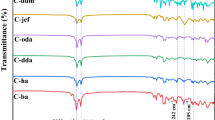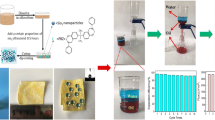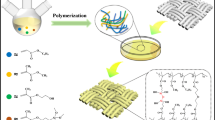Abstract
Eugenol (E) based mono-functional benzoxazine(E-x) monomers were prepared using different long-chain monoamines(x = ba, ha, dda, oda) and fluorine substituted aromatic monoamine (x = fa). The molecular structure of the monomers developed was characterized by FTIR and NMR spectral analysis. Further, the prepared monomers were coated over the cotton fabric and studied for their surface behavior. The poly(E-dda) coated cotton fabric exhibits the higher value of water contact angle (WCA = 151°) than that of other samples coated with polybenzoxazines(E-ba, E-ha,E-oda, and E-fa). Furthermore, poly(E-dda) coated cotton fabrics also displayed the lower value of surface energy of 15.6 mN/m with a lower sliding angle value(11°) than those of other coated cotton fabric samples. The formation of rough surfaces on the fabric was ascertained from microstructure analysis and thereby contributes to superhydrophobicity along with pH robustness. Subsequently, the oil-water separation efficiency and flux of the poly(E-dda) coated cotton fabric was found to be 98% and 5800 L/m2h respectively. It was also observed that the specimen of a glass substrate coated with poly(E-dda) exhibited the delayed ice formation. Data obtained from different studies, it is suggested that the eugenol-dodecylamine(E-dda) based benzoxazine can be effectively employed as an alternate to fluorine-based polymers.












Similar content being viewed by others
References
Wang CF, Wang YT, Tung PH et al (2006) Stable superhydrophobic polybenzoxazine surfaces over a wide pH range. Langmuir 22:8289–8292. https://doi.org/10.1021/la061480w
Rajamanikam R, Pichaimani P, Kumar M, Muthukaruppan A (2017) Optical and thermomechanical behavior of benzoxazine functionalized ZnO reinforced polybenzoxazine nanocomposites. Polym Compos 38:1881–1889. https://doi.org/10.1002/pc.23758
Zhang W, Lu X, Xin Z, Zhou C (2016) Development of a superhydrophobic polybenzoxazine surface with self-cleaning and reversible water adhesion properties. RSC Adv 6:106054–106063. https://doi.org/10.1039/C6RA22524A
Wang CF, Su YC, Kuo SW et al (2006) Low-surface-free-energy materials based on polybenzoxazines. Angew Chem Int Ed 45:2248–2251. https://doi.org/10.1002/anie.200503957
Xue Z, Wang S, Lin L et al (2011) A novel superhydrophilic and underwater superoleophobic hydrogel-coated mesh for oil/water separation. Adv Mater 23:4270–4273. https://doi.org/10.1002/adma.201102616
Xue Z, Cao Y, Liu N et al (2014) Special wettable materials for oil/water separation. J Mater Chem A 2:2445–2460
Broje V, Keller AA (2006) Improved mechanical oil spill recovery using an optimized geometry for the skimmer surface. Environ Sci Technol 40:7914–7918. https://doi.org/10.1021/es061842m
Dubansky B, Whitehead A, Miller JT et al (2013) Multitissue molecular, genomic, and developmental effects of the deepwater horizon oil spill on resident Gulf killifish (Fundulus grandis). Environ Sci Technol 47:5074–5082. https://doi.org/10.1021/es400458p
Gogoi N, Rastogi D, Jassal M, Agrawal AK (2014) Low-surface-energy materials based on polybenzoxazines for surface modification of textiles. J Text Inst 105:1212–1220. https://doi.org/10.1080/00405000.2014.882042
Zhang T, Yan H, Fang Z et al (2014) Superhydrophobic and conductive properties of carbon nanotubes/polybenzoxazine nanocomposites coated ramie fabric prepared by solution-immersion process. Appl Surf Sci 309:218–224. https://doi.org/10.1016/j.apsusc.2014.05.013
Zhang W, Lu X, Xin Z, Zhou C (2015) A self-cleaning polybenzoxazine/TiO2 surface with superhydrophobicity and superoleophilicity for oil/water separation. Nanoscale 7:19476–19483. https://doi.org/10.1039/c5nr06425b
Caldona EB, De Leon ACC, Thomas PG et al (2017) Superhydrophobic rubber-modified polybenzoxazine/SiO2 nanocomposite coating with anticorrosion, anti-ice, and superoleophilicity properties. Ind Eng Chem Res 56:1485–1497. https://doi.org/10.1021/acs.iecr.6b04382
Li Y, Yu Q, Yin X et al (2018) Fabrication of superhydrophobic and superoleophilic polybenzoxazine-based cotton fabric for oil–water separation. Cellulose 25:6691–6704. https://doi.org/10.1007/s10570-018-2024-8
Lehmler HJ, Liu B, Gadogbe M, Bao W (2018) Exposure to Bisphenol A, Bisphenol F, Bisphenol S in U.S. adults and children: The National Health and Nutrition Examination Survey 2013–2014. ACS Omega 3:6523–6532. https://doi.org/10.1021/acsomega.8b00824
Okada H, Tokunaga T, Liu X et al (2008) Direct evidence revealing structural elements essential for the high binding ability of bisphenol a to human estrogen-related receptor-γ. Environ Health Perspect 116:32–38. https://doi.org/10.1289/ehp.10587
Hariharan A, Prabunathan P, Kumaravel A et al (2020) Bio-based polybenzoxazine composites for oil-water separation, sound absorption and corrosion resistance applications. Polym Test 86:106443. https://doi.org/10.1016/j.polymertesting.2020.106443
Hariharan A, Prabunathan P, Subramanian SS et al (2020) Blends of chalcone benzoxazine and bio-benzoxazines coated cotton fabrics for oil–water separation and bio-silica reinforced nanocomposites for low-k applications. J Polym Environ 28:598–613. https://doi.org/10.1007/s10924-019-01629-2
Manickam M, Pichaimani P, Arumugam H, Muthukaruppan A (2019) Synthesis of nontoxic pyrazolidine-based benzoxazine-coated cotton fabric for oil-water separation. Ind Eng Chem Res 58:21419–21430. https://doi.org/10.1021/acs.iecr.9b03440
Liu X, Li Z, Zhan G et al (2019) Bio-based benzoxazines based on sesamol: synthesis and properties. J Appl Polym Sci 136:48255. https://doi.org/10.1002/app.48255
Zhang Y, Liu X, Zhan G et al (2019) Study on the synergistic anticorrosion property of a fully bio-based polybenzoxazine copolymer resin. Eur Polym J 119:477–486. https://doi.org/10.1016/j.eurpolymj.2019.07.020
Liu X, Zhang R, Li T et al (2017) Novel fully biobased benzoxazines from rosin: synthesis and properties. ACS Sustain Chem Eng 5:10682–10692. https://doi.org/10.1021/acssuschemeng.7b02650
Prabunathan P, Vasanthakumar A, Manoj M et al (2020) Polypyrrole inter-layered low temperature curing benzoxazine matrices with enhanced thermal and dielectric properties. J Polym Res 27:1–14. https://doi.org/10.1007/s10965-020-2022-z
Khalil AA, Rahman UU, Khan MR et al (2017) Essential oil eugenol: sources, extraction techniques and nutraceutical perspectives. RSC Adv 7:32669–32681. https://doi.org/10.1039/c7ra04803c
Thirukumaran P, Shakila A, Muthusamy S (2014) Synthesis and characterization of novel bio-based benzoxazines from eugenol. RSC Adv 4:7959–7966. https://doi.org/10.1039/c3ra46582a
Dumas L, Bonnaud L, Olivier M et al (2015) Eugenol-based benzoxazine: from straight synthesis to taming of the network properties. J Mater Chem A 3:6012–6018. https://doi.org/10.1039/c4ta06636g
Thirukumaran P, Parveen AS, Sarojadevi M (2014) Synthesis and copolymerization of fully biobased benzoxazines from renewable resources. ACS Sustain Chem Eng 2:2790–2801. https://doi.org/10.1021/sc500548c
Krishnan S, Arumugam H, Chavali M, Muthukaruppan A (2019) High dielectric, low curing with high thermally stable renewable eugenol-based polybenzoxazine matrices and nanocomposites. J Appl Polym Sci 136:1–11. https://doi.org/10.1002/app.47050
Yao H, Lu X, Xin Z et al (2019) A durable bio-based polybenzoxazine/SiO2 modified fabric with superhydrophobicity and superoleophilicity for oil/water separation. Sep Purif Technol 229:115792. https://doi.org/10.1016/j.seppur.2019.115792
Thennarasu P, Prabunathan P, Senthilkumar M (2018) Development of biomass-derived functionalized activated carbon-coated and polyaniline-grafted cotton fabric with enhanced ultraviolet resistance. J Ind Text 47:1609–1625. https://doi.org/10.1177/1528083717702008
Rao BS, Palanisamy A (2011) Monofunctional benzoxazine from cardanol for bio-composite applications. React Funct Polym 71:148–154. https://doi.org/10.1016/j.reactfunctpolym.2010.11.025
Lu R, Gan W, Wu BH et al (2005) C-H stretching vibrations of methyl, methylene and methine groups at the vapor/Alcohol (n = 1–8) interfaces. J Phys Chem B 109:14118–14129. https://doi.org/10.1021/jp051565q
Rao BS, Palanisamy A (2012) A new thermo set system based on cardanol benzoxazine and hydroxy benzoxazoline with lower cure temperature. Prog Org Coatings 74:427–434. https://doi.org/10.1016/j.porgcoat.2012.01.006
Parveen AS, Thirukumaran P, Sarojadevi M (2014) Low dielectric materials from fluorinated polybenzoxazines. Polym Adv Technol 25:1538–1545. https://doi.org/10.1002/pat.3398
Bonnaud L, Chollet B, Dumas L et al (2019) High-performance bio-based benzoxazines from enzymatic synthesis of diphenols. Macromol Chem Phys 220:1800312. https://doi.org/10.1002/macp.201800312
Gomez IJ, Arnaiz B, Cacioppo M et al (2018) Nitrogen-doped carbon nanodots for bioimaging and delivery of paclitaxel. J Mater Chem B 6:7634–7639. https://doi.org/10.1039/x0xx00000x
Lin RC, Kuo SW (2018) Well-defined benzoxazine/triphenylamine-based hyperbranched polymers with controlled degree of branching. RSC Adv 8:13592–13611. https://doi.org/10.1039/c8ra00506k
Uyar T, Hacaloglu J, Ishida H (2013) Synthesis, characterization, and thermal properties of alkyl-functional naphthoxazines. J Appl Polym Sci 127:3114–3123. https://doi.org/10.1002/app.37692
Ishida H (2011) Overview and historical background of polybenzoxazine research. Elsevier B.V, New York
Liu J, Lu X, Xin Z, Zhou C (2016) Surface properties and hydrogen bonds of mono-functional polybenzoxazines with different N-substituents. Chin J Polym Sci (English Ed) 34:919–932. https://doi.org/10.1007/s10118-016-1810-8
Allen DJ, Ishida H (2009) Effect of phenol substitution on the network structure and properties of linear aliphatic diamine-based benzoxazines. Polymer 50:613–626. https://doi.org/10.1016/j.polymer.2008.11.007
Rao BS, Surendra P (2016) Synthesis and characterization of difunctional benzoxazines from aromatic diester diamine containing varying length of aliphatic spacer group: polymerization, thermal and viscoelastic characteristics. Eur Polym J 77:139–154. https://doi.org/10.1016/j.eurpolymj.2016.02.003
Allen DJ, Ishida H (2007) Polymerization of linear aliphatic diamine-based benzoxazine resins under inert and oxidative environments. Polymer 48:6763–6772. https://doi.org/10.1016/j.polymer.2007.09.003
Agag T, Akelah A, Rehab A, Mostafa S (2012) Flexible polybenzoxazine thermosets containing pendent aliphatic chains. Polym Int 61:124–128. https://doi.org/10.1002/pi.3156
Arumugam H, Krishnan S, Chavali M, Muthukaruppan A (2018) Cardanol based benzoxazine blends and bio-silica reinforced composites: thermal and dielectric properties. New J Chem 42:4067–4080. https://doi.org/10.1039/c7nj04506a
Prabunathan P, Alagar M (2017) Polybenzoxazine-based organic-inorganic nanohybrid materials for high performance engineering applications. In: Ishida H (ed) Advanced and emerging polybenzoxazine science and technology. Elsevier, New York, pp 801–834
Prabunathan P, Thennarasu P, Song JK, Alagar M (2017) Achieving low dielectric, surface free energy and UV shielding green nanocomposites: via reinforcing bio-silica aerogel with polybenzoxazine. New J Chem 41:5313–5321. https://doi.org/10.1039/c7nj00138j
Ge M, Cao C, Liang F et al (2020) A “pDMS-in-water” emulsion enables mechanochemically robust superhydrophobic surfaces with self-healing nature. Nanoscale Horizons 5:65–73. https://doi.org/10.1039/c9nh00519f
Lahiri SK, Zhang P, Zhang C, Liu L (2019) Robust fluorine-free and self-healing superhydrophobic coatings by H3BO3 incorporation with SiO2–Alkyl-Silane@PDMS on cotton fabric. ACS Appl Mater Interfaces 11:10262–10275. https://doi.org/10.1021/acsami.8b20651
Sasaki K, Tenjimbayashi M, Manabe K, Shiratori S (2016) Asymmetric superhydrophobic/superhydrophilic cotton fabrics designed by spraying polymer and nanoparticles. ACS Appl Mater Interfaces 8:651–659. https://doi.org/10.1021/acsami.5b09782
Jeevahan J, Chandrasekaran M, Britto Joseph G et al (2018) Superhydrophobic surfaces: a review on fundamentals, applications, and challenges. J Coatings Technol Res 15:231–250
Jin M, Li S, Wang J et al (2012) Controllable fabrication of organosilane nano-architectured surfaces with tunable wettability. Appl Surf Sci 258:7552–7555. https://doi.org/10.1016/j.apsusc.2012.04.084
Reshmi CR, Sundaran SP, Juraij A, Athiyanathil S (2017) Fabrication of superhydrophobic polycaprolactone/beeswax electrospun membranes for high-efficiency oil/water separation. RSC Adv 7:2092–2102. https://doi.org/10.1039/c6ra26123j
Jiang D, Fan P, Gong D et al (2016) High-temperature imprinting and superhydrophobicity of micro/nano surface structures on metals using molds fabricated by ultrafast laser ablation. J Mater Process Technol 236:56–63. https://doi.org/10.1016/j.jmatprotec.2016.05.009
He M, Wang J, Li H, Song Y (2011) Super-hydrophobic surfaces to condensed micro-droplets at temperatures below the freezing point retard ice/frost formation. Soft Matter 7:3993–4000. https://doi.org/10.1039/c0sm01504k
Acknowledgements
The authors thank the PSG Management for their financial and moral support. The authors also acknowledge the SIF, VIT-Vellore for providing NMR facility.
Author information
Authors and Affiliations
Corresponding authors
Ethics declarations
Conflict of interest
All authors declare that they have no conflict of interest.
Additional information
Publisher's Note
Springer Nature remains neutral with regard to jurisdictional claims in published maps and institutional affiliations.
Electronic Supplementary Material
Below is the link to the electronic supplementary material.
Rights and permissions
About this article
Cite this article
Dinesh Kumar, G., Prabunathan, P., Manoj, M. et al. Fluorine Free Bio-Based Polybenzoxazine Coated Substrates for Oil-Water Separation and Anti-Icing Applications. J Polym Environ 28, 2444–2456 (2020). https://doi.org/10.1007/s10924-020-01782-z
Published:
Issue Date:
DOI: https://doi.org/10.1007/s10924-020-01782-z




